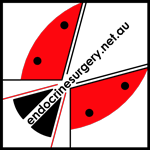Hashimoto's Thyroiditis
Thyroiditis is an inflammatory condition of the thyroid and has a number of causes, which may be focal or diffuse, and are often associated with either over- or underactivity of the thyroid. The major types of thyroiditis are listed below:
- Hashimoto's thyroiditis (this page)
- Subacute (nonsuppurative or 'de Quervain's') thyroiditis
- Reidel's thyroiditis
- Postpartum thyroiditis
- Silent thyroiditis
- Radiation thyroiditis
- Amiodarone-induced thyroiditis
All other causes of thyroiditis detailed above, besides the most common type of Hashimoto's thyroiditis, are dealt with on a separate webpage Other Causes.
 Fig.1: Dr Hakaru HashimotoHashimoto's Thyroiditis (Autoimmune Chronic Lymphocytic Thyroiditis) is the most common cause of thyroiditis. It was first described in 1912 by Hakaru Hashimoto (Fig. 1), a Japanese physician, when he studied four women with an enlarged thyroid that appeared to have been transformed into lymphoid tissue (‘struma lymphomatosa’).
Fig.1: Dr Hakaru HashimotoHashimoto's Thyroiditis (Autoimmune Chronic Lymphocytic Thyroiditis) is the most common cause of thyroiditis. It was first described in 1912 by Hakaru Hashimoto (Fig. 1), a Japanese physician, when he studied four women with an enlarged thyroid that appeared to have been transformed into lymphoid tissue (‘struma lymphomatosa’).
More than 40 years later the presence of antithyroid antibodies was found in patients with this disorder, which is now recognised as a form of chronic autoimmune thyroiditis.
The process is thought to begin with activation of CD4 (helper) T lymphocytes specific for thyroid antigens, with the production of autoantibodies to the thyroid-specific antigens thyroglobulin and thyroperoxidase. It leads to hypothyroidism due to destruction and eventual fibrous replacement of follicular cells.
Autoimmune thyroiditis is clearly multifactorial in aetiology with contributions from both genetic and environmental factors. Thyroid autoimmunity is familial, with up to 50% of first-degree relatives of patients with chronic autoimmune thyroiditis having antibodies.
Incidence
This is the most common cause of hypothyroidism (underactive thyroid) in Australia, as described on webpage Hypothyroidism. It is up to 15 times more common in women than men and presents with all the symptoms of hypothyroidism. It is most common in the fourth to sixth decades, when the prevalence of antithyroid antibodies in women is 12%. Its incidence appears to be increasing. Classical Hashimoto’s disease, with an enlarged, firm, bosselated thyroid gland, is less common than the atrophic form. It may be associated with other autoimmune conditions such as diabetes mellitus, coeliac disease or Addison's disease.
Symptoms
Hashimoto's thyroiditis begins as a gradual enlargement of the thyroid gland and gradual development of hypothyroidism. The goitre of Hashimoto's thyroiditis may remain unchanged for decades, but usually it gradually increases in size. Occasionally the course is marked by symptoms of mild thyrotoxicosis, especially during the early phase of the disease.
Symptoms and signs of mild hypothyroidism may be present in 20% of patients when first seen, or commonly develop over a period of several years. Progression from subclinical hypothyroidism (normal T4 but elevated TSH) to overt hypothyroidism occurs in about 3-5% of patients per year. Eventually thyroid atrophy and myxedema may occur.
In classical Hashimoto’s disease the thyroid is diffusely enlarged, although the goitre may be asymmetrical. The thyroid has a rubbery feel, but is painless and non-tender and compression symptoms are rare (and should raise the suspicion of cancer).
Diagnosis
The diagnosis is made by measurement of thyroid function tests, which show hypothyroidism. Thyroid antibodies in the blood confirm the diagnosis, with antithyroglobulin and antiperoxidase antibodies raised in more than 90% and 70% respectively. The thyroid scan is unnecessary in most patients, but will show an irregular patchy uptake.
 Fig.2: Hashimoto's thyroiditis cytology showing lymphocytes and Hurthle cell metaplasiaFNA cytology can make the diagnosis and is especially indicated if there is a suspicious nodule or rapidly-enlarging goitre. Characteristic cytological features are abundant polymorphic lymphocytes, both isolated and intraepithelial, plasma cells and Hurthle cell metaplasia (Fig. 2).
Fig.2: Hashimoto's thyroiditis cytology showing lymphocytes and Hurthle cell metaplasiaFNA cytology can make the diagnosis and is especially indicated if there is a suspicious nodule or rapidly-enlarging goitre. Characteristic cytological features are abundant polymorphic lymphocytes, both isolated and intraepithelial, plasma cells and Hurthle cell metaplasia (Fig. 2).
FNA cytology needs to be interpreted with caution however, as atypical cells are found quite often as a result of the thyroiditis, especially Hurthle cell change.
The condition is potentially premalignant and any suspicious nodules should be biopsied to exclude lymphoma (MALT). There is an increased incidence of lymphoma and papillary thyroid cancer (PTC) in Hashimoto's thyroiditis, and up to 35% of patients undergoing surgery have unsuspected thyroid cancer. However there is evidence that thyroid cancer in a thyroiditis-affected gland has a better prognosis.
Treatment
Treatment is with thyroid hormone replacement with thyroxine, which will decrease the thyroid swelling, and the reduction in size may be rapid and marked.
Surgery is very rarely indicated for uncomplicated Hashimoto's thyroiditis but may be necessary for pressure symptoms or to exclude lymphoma. Most patients however will never need surgery, but the underlying risk of thyroid cancer means that all patients with Hashimoto's thyroiditis should have a yearly examination of their thyroid and any new nodules should be investigated.

